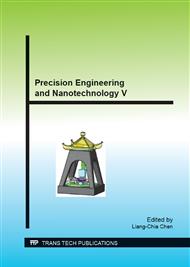p.458
p.463
p.469
p.475
p.483
p.489
p.496
p.505
p.511
Developing in Biodegradable Stents Technology
Abstract:
Biodegradable stents have been used for the treatment of cardiovascular diseases and are often placed inside coronary arteries. The manufacture of Biodegradable stents is an challenging issue because of the features, like geometry design, machine processing way and the material select of stents. An improved manufacturing process of biodegradable stents is presented. The proposed processes consist of the following steps: tube drawing (is use tube sinking manufacture), laser cutting and surface modification (annealing and ultrasonic cleaning). The precision injection and drawing operation is used to obtain the required wall thickness for seamless tube. The laser cutting is performed to change the shape of the stent, and the finishing operations are selected to modify the surface features, like smoothness and texture of stents. The smoothness of surface finish is one of the properties that determine the performance of a stent. Therefore, the surface modification process (vacuum annealing and ultrasonic cleaning) is important in the production of stents and in clinical treatments involving stents. Annealing is the key technology that affects the material’s final crystal grain size. Ultrasonic clean was of the stents to remove the slag (oxides) and burrs formed in laser production. Poly Lactic Acid material sample with an outside-diameter of 1.5 mm, a wall thickness of 0.08 mm, and a length of 10 mm, had been manufactured and demonstrated the proposed manufacture technology. The surface roughness of a stent manufactured is the value of Ra 13.7 nm which basically meets the design requirement for further performance evaluation. It is hoped that the above finding can be used for future study of stents.
Info:
Periodical:
Pages:
483-488
Citation:
Online since:
August 2014
Authors:
Keywords:
Price:
Сopyright:
© 2015 Trans Tech Publications Ltd. All Rights Reserved
Share:
Citation:


